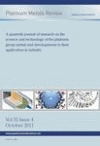-
oa Formation and Decomposition of Palladium Hydride Particles
- Source: Platinum Metals Review, Volume 42, Issue 4, Oct 1998, p. 141 - 144
Abstract
Nanoscale changes in surface structure that accompany the low temperature exposure of palladium to hydrogen are reported. Field Emission Microscopy, a method for rapid in situ imaging of surface processes, has been used to examine palladium tips of radius ∼ 200 nm, produced by a novel technique. Images are presented of the initial stages of the uptake of hydrogen. Subsurface hydrides were initially formed when palladium tips were exposed to hydrogen gas at low temperatures, starting at highly open surfaces present on the tip. Extruding PdH particles were also formed on top of the palladium tip and their growth was observed to proceed in a ‘staccato’-like manner. Palladium crystallites remained on the surface after most of the hydrogen had been removed from the palladium sample by heating in vacuum. On heating the crystallites remained quite stable up to a temperature of ∼ 700 K, but then melted back into the tip.


